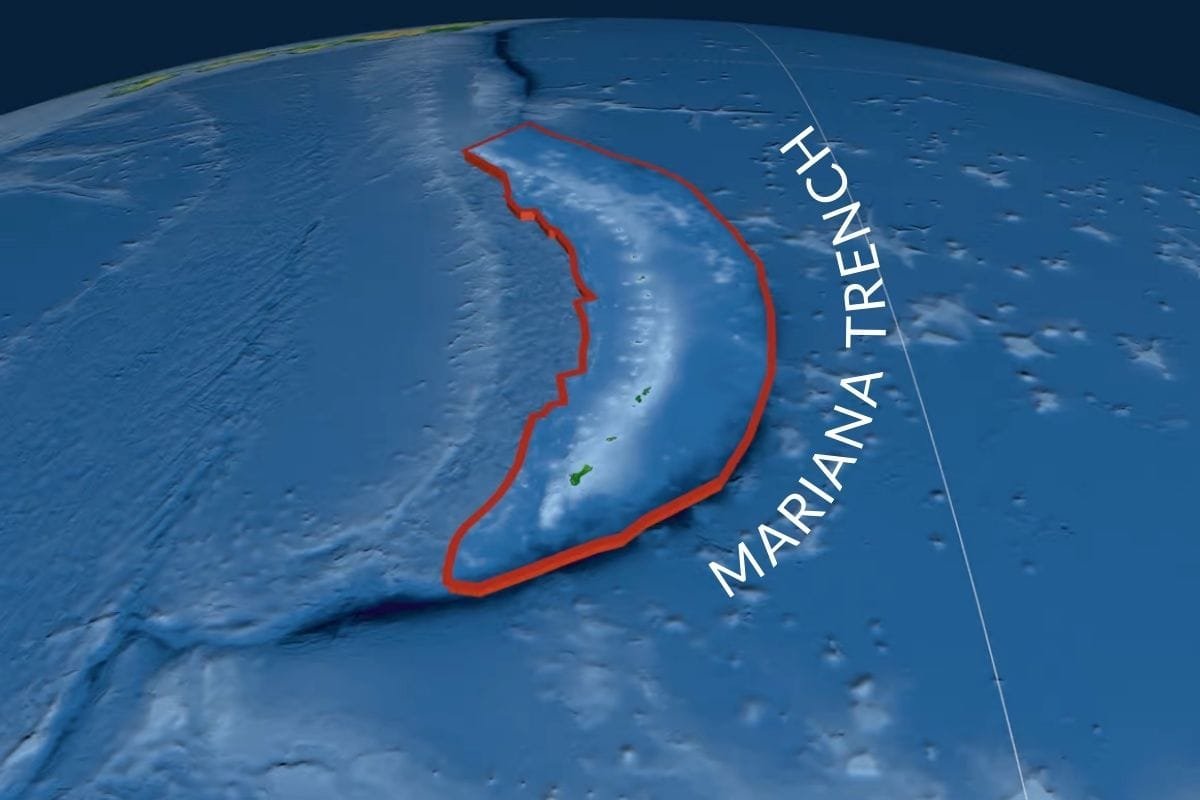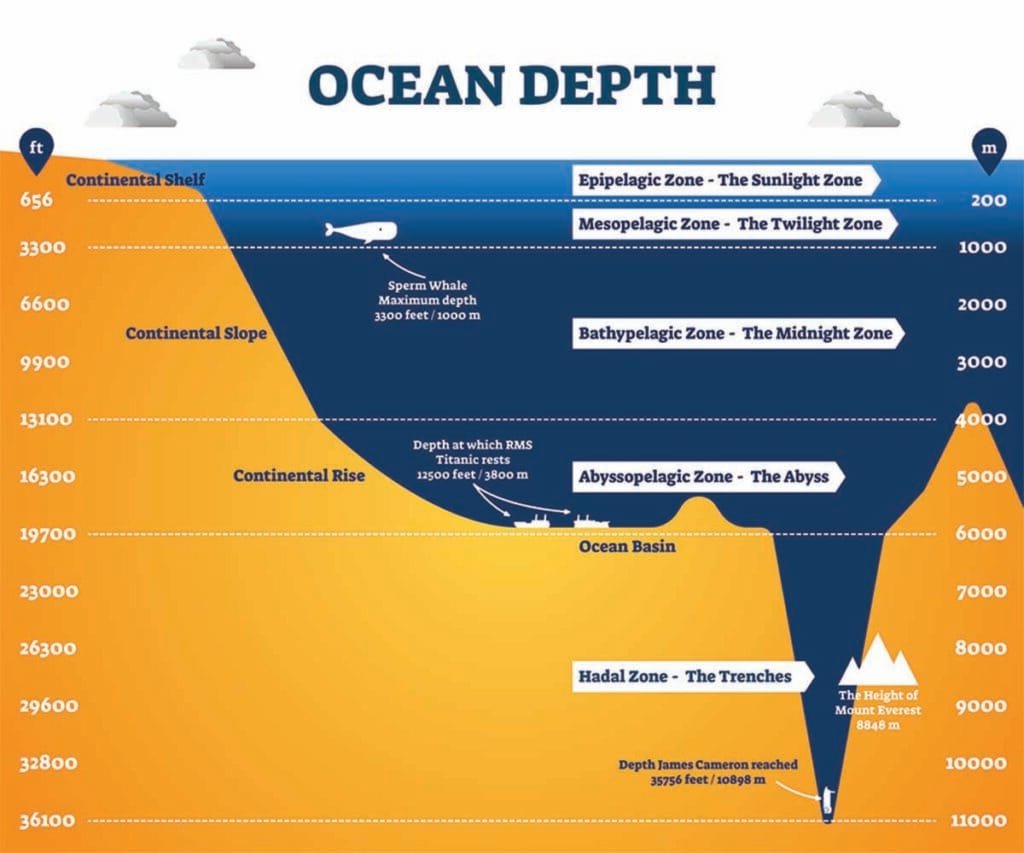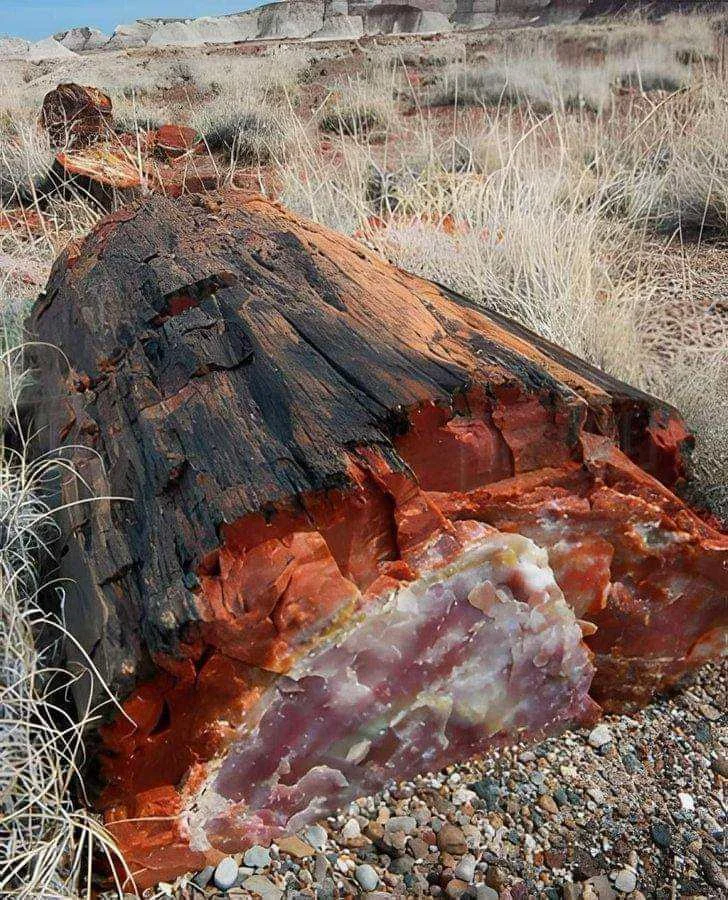The Mystery of the Mariana Trench – What Lurks in the Deepest Place on Earth?
The ocean is full of mysteries. Imagine a place where sunlight hasn’t reached in over a billion years, where the water is colder than ice yet flows freely. The pressure at its deepest point, the Challenger Deep, is more than 1,000 times what we experience on the surface- enough to crush human bones and destroy submarines not built to withstand it. This is the Mariana Trench, the deepest part of the ocean- and the deepest point on Earth. To put that into perspective, if Mount Everest, the tallest mountain on Earth, were placed in the trench, its peak would still be submerged by more than 2 kilometers (1.2 miles) of underwater.
Located in the western Pacific Ocean, east of the Mariana Islands, this massive underwater canyon stretches over 1,580 miles long and reaches depths of nearly 11 kilometers (36,000 feet). Let’s take a journey into the unknown and explore the fascinating, eerie, and mysterious world of the Mariana Trench.

How Was the Mariana Trench Formed?
The Mariana Trench was formed millions of years ago by the movement of tectonic plates, specifically through a process called subduction. This occurs when one tectonic plate slides beneath another. In this case, the Pacific Plate, which is heavier and denser, is being forced beneath the Philippine Plate at their boundary.

As the Pacific Plate sinks deep into the Earth’s mantle, it creates a long, narrow depression in the ocean floor. This continuous movement has shaped the trench into its current form, which stretches 1,580 miles long and reaches depths of nearly 11 kilometers (36,000 feet).
Subduction also causes intense geological activity, such as earthquakes and the formation of underwater volcanoes, making the trench an important site for studying Earth’s dynamic processes. Over millions of years, this ongoing collision has kept the Mariana Trench as the deepest and most extreme underwater feature on the planet.

How Was the Mariana Trench Discovered?
The Mariana Trench was first discovered in 1875 during the British HMS Challenger expedition, the first scientific journey to explore the deep ocean. Using a weighted rope to measure depth, the crew identified a spot in the western Pacific Ocean that was deeper than anything they had ever recorded. This marked the first known documentation of what we now call the Mariana Trench.
Later, in 1951, a ship called HMS Challenger II returned to study the area using new sonar technology. This method allowed scientists to send sound waves to the ocean floor and measure their return time, providing a much more accurate map of the trench. It was during this expedition that the Challenger Deep, the deepest part of the trench, was officially identified the depth of the trench and it confirmed that it was 36,000 feet or approximately 11 km deep.
The first successful dive to the deepest point, known as the Challenger Deep, was made on January 23, 1960, by Jacques Piccard and U.S. Navy Lieutenant Don Walsh in the bathyscaphe Trieste. Their descent took nearly five hours, but due to the extreme pressure, they could only dive for 20 minutes. While they were unable to take any pictures, they reported seeing what appeared to be a flatfish at the bottom, though later studies suggested it might have been a sea cucumber.

In 2012, filmmaker James Cameron made history by completing a solo dive to the Challenger Deep in the Deepsea Challenger submersible. During his expedition, he captured high-definition footage, collected samples, and recorded the trench’s eerie silence, occasionally interrupted by strange sounds. His discoveries revealed a wide variety of microscopic organisms thriving in the harsh environment, and he also became the first person to create a 3D film of the trench’s floor.

The Mariana Trench is about 2,550 kilometers (1,580 miles) long and averages 69 kilometers (43 miles) in width. Its deepest point, the Challenger Deep, was named after the British ship HMS Challenger, which first measured its depth during an expedition from 1872 to 1876.
To date, the Challenger Deep has been reached only four times, by the Trieste in 1960, the Japanese probe Kaiko in 1995, the U.S. probe Nereus in 2009, and James Cameron’s submersible in 2012.
Conspiracy Theories
The Mariana Trench, with its extreme depths and isolation has given rise to numerous conspiracy theories, each adding an air of intrigue to this already mysterious place. Here are a few of the most intriguing,
Secret Government Experiments
One of the most popular conspiracy theories about the Mariana Trench is that it might be the site of a secret government research facility. Supporters of this idea believe the trench is a perfect location for top-secret experiments because it is so remote and difficult to access. According to the theory, this hidden facility could be used for projects like developing advanced weapons or studying extraterrestrial life. However, there is no solid evidence to support these claims, so it remains just a theory for now.
Alien Base
Another widely discussed theory is that the Mariana Trench could be home to a secret alien base. Supporters of this idea believe that the trench’s extreme depth and isolation make it an ideal hiding spot for extraterrestrial life. They also point to the strange-looking creatures found in the trench, suggesting these species might be the result of alien genetic experiments. While these unusual sea creatures fuel the imagination, there is no evidence to confirm this theory. Could it be true? That’s up to you to decide.
Lost Civilizations
Some people believe that the Mariana Trench hides evidence of ancient civilizations. This theory suggests that the trench may have once been above water, providing a place for early civilizations to settle. Supporters point to alleged underwater structures and artifacts found in the area, claiming they could be remains of a lost civilization.
What do you think of this idea? While these theories may sound unlikely to some, they have gained a lot of attention online. The thought of hidden civilizations, alien bases, or secret government projects adds to the fascination surrounding the Mariana Trench, making it a perfect setting for mysterious stories and speculation.
None of these theories have any scientific evidence, but they continue to fuel the trench’s mysterious reputation.
What’s at the bottom of the Mariana Trench?
Over the years, despite the harsh conditions, scientists have made amazing discoveries in the Mariana Trench. Over 200 microorganisms and small creatures have been found here, each uniquely adapted to survive in the dark and high-pressure environment.
In 1960, during their historic descent to the Challenger Deep, the crew of the Trieste observed the seabed covered in diatomaceous ooze, a soft layer of sediment formed by microscopic algae. They also reported seeing what looked like a flatfish, but later studies suggested it might have been a sea cucumber. Subsequent dives, such as those by the Kaiko probe and the Nereus probe, revealed more life at these depths, including sea cucumbers, scale worms, shrimp, and even a small polychaete worm about an inch long.

The Kaiko probe, equipped with a video camera, spotted a sea cucumber, a scale worm and a shrimp at the bottom of the Challenger Deep. Later, the Nereus probe also contributed to the study, spotting a polychaete worm about an inch long, living at the trench’s deepest point.
Sediment samples collected during these missions have provided even more surprising insights. Scientists found large numbers of soft-shelled foraminifera, tiny organisms that thrive under the immense pressure of nearly 11 kilometers (36,000 feet) of water. In the Challenger Deep, about 85% of the sediment’s organisms were soft-shelled, a stark contrast to other deep-sea environments, where only 5-20% of foraminifera are soft-shelled. Researchers believe these unique adaptations help them survive in a world where calcium carbonate, essential for hard shells, dissolves due to the pressure.
The deepest parts of our oceans, the region between 6000 and 11 0000 m depth, is known as the hadal zone, and it represents some of the most active and diverse marine habitat on Earth. The trench’s extreme environment forces its inhabitants to develop incredible adaptations, such as transparent bodies, cartilage instead of bones, and the ability to produce light through bioluminescence.

some of the strange creatures found with later discoveries in the Mariana Trench include the anglerfish, Dumbo octopus, goblin shark, frilled shark, telescope octopus, and snailfish. Even zombie worms, which survive by feeding on bones, make this dark and pressurized environment their home. These unique organisms thrive without sunlight and under crushing pressure, showcasing nature’s ability to adapt to the unimaginable.
The Mariana Trench is technically part of U.S. territory. Recognizing its ecological importance and vulnerability to human interference, President George W. Bush declared it a marine national monument in 2009. This designation protects much of the trench, its surrounding seafloor, and nearby underwater volcanoes as a marine reserve, safeguarding its unique ecosystems from exploitation or damage.
One of the strangest things that have emanated from the Mariana Trench is not a sea monster but a mysterious sound. In 2014, scientists used robotic gliders to record ocean noises near the trench and captured an unusual, mechanical-sounding noise, later called the “Western Pacific Biotwang”. This eerie, 3.5-second “twangy” sound repeated several times during the study, and while it seemed otherworldly, researchers eventually linked it to the minke whale, a peculiar small whale that can sound like a Star Wars sound effect. However, many mysteries about the minke whale’s behavior and calls remain unsolved, including why this sound occurs year-round.
Interestingly, this isn’t the first time that minke whales have baffled scientists. For decades, researchers were puzzled by a strange, duck-like underwater sound. The noise was so rhythmic and repetitive that it seemed artificial, far too loud to come from any fish. It wasn’t until 2014 that scientists identified the source of the mysterious “bio-duck” sound as minke whales, solving a 50-year-old mystery.
In 2018 the movie ‘The Meg’ introduced the idea of giant Megalodon sharks haunting in the depth of Mariana Trench. The film imagined a “fake” bottom, behind which these prehistoric creatures lurked undetected. While it makes for an entertaining concept, the scientific reality is quite different. Megalodon sharks thrived in shallow, warm waters and would not have survived in the trench’s cold, resource-limited environment.
Still, the idea of Megalodons hiding in the depths of the ocean adds to the enduring allure of the Mariana Trench as a realm of mystery and imagination.
The Future of Exploration
The Mariana Trench, even though it is the deepest known point on Earth, has not escaped the impact of human activity. Pollution, particularly microplastics, has been found even in this remote corner of the world, serving as a stark reminder of the far-reaching impact of human actions.
In 2019, a diver exploring the trench reported finding candy wrappers and a plastic bag at a depth of 35,849 feet, nearly the deepest point of the trench. This was a shocking realization that even a place as seemingly inaccessible as the Mariana Trench has been contaminated by human waste.

The consequences of this pollution are already becoming evident. Many deep-sea creatures, like amphipods, have been found consuming plastics and microfibers from the ocean floor. These tiny creatures are a crucial part of the ocean food chain, so changes to their diet may have serious consequences for the entire ecosystem. While it’s still unclear how this will affect them in the long term, scientists worry that the results could be harmful for marine life and the ocean’s overall health.
However, research and exploration of the trench continues. Scientists from around the world are working together to study its unique environment and uncover new secrets about life in this deep sea wonder for future generations. The organisms that thrive in the trench have adapted to conditions that would be lethal to most life on Earth- crushing pressure, freezing temperatures, and complete darkness. Studying these adaptations can help scientists better understand the limits of life and how it evolves to survive in extreme environments. This knowledge can offer insights into the history of life on Earth and even inform the search for life on other planets with similarly harsh conditions.
Protecting the trench is important not just to keep its natural beauty but also to make sure its unique ecosystems can continue to be studied. Pollution at these depths can harm the delicate balance of life in the trench and even affect marine life far beyond it.
To protect the trench, scientists and conservationists are working to understand where the pollution is coming from and how it impacts the creatures living there. By spreading awareness and taking steps to reduce the waste that enters our oceans, we can help preserve this special place. Protecting the trench is not only about science but also about saving one of Earth’s greatest underwater treasures for future generations to explore and admire.
Mariana Trench Frequently Asked Questions (FAQ)
The Mariana Trench is the deepest part of the world’s oceans, reaching nearly 36,000 feet (11,000 meters) deep in the Pacific Ocean. Its extreme depth, crushing pressure, and bizarre deep-sea creatures make it one of the most mysterious and least explored places on Earth.
The Mariana Trench is the deepest part of the world’s oceans, located in the western Pacific Ocean, east of the Mariana Islands. It stretches about 1,580 miles long and reaches a depth of nearly 11 kilometers (36,000 feet) at its deepest point, the Challenger Deep.
The trench was formed by tectonic activity. It is the result of the Pacific Plate being pushed underneath the Philippine Plate in a process called subduction. This created a deep, narrow depression in the ocean floor over millions of years.
Yes. The Mariana Trench is the deepest part of the ocean. To put this into perspective, if Mount Everest, the tallest mountain on Earth, were placed in the trench, its peak would still be submerged by more than 2 kilometers (1.2 miles) of water.
Yes, but very few people have visited the trench due to its extreme depth and pressure. The first manned dive was in 1960 by Jacques Piccard and Don Walsh in the submersible Trieste. Filmmaker James Cameron also completed a solo dive in 2012 using the Deepsea Challenger.
The trench is home to unique and strange creatures like snailfish, anglerfish, Dumbo octopuses, and zombie worms. Many organisms, such as bioluminescent species, have adapted to survive in complete darkness, freezing temperatures, and immense pressure.
The pressure at the bottom of the Mariana Trench is over 15,750 pounds per square inch (PSI), more than 1,000 times the pressure at sea level. This immense force can easily crush most objects and is a major challenge for deep-sea exploration.
Only a handful of people have reached the bottom of the trench. The first dive was made by Jacques Piccard and Don Walsh in 1960 aboard the submersible Trieste. Since then, a few others, including filmmaker James Cameron in 2012, have made successful descents. In total, fewer than 25 people have reached the trench’s depths, making it an achievement rarer than walking on the Moon.
The Challenger Deep is the deepest point within the Mariana Trench and the deepest known location on Earth. It was named after the British ship HMS Challenger, which first measured its depth during an expedition from 1872 to 1876.
No, humans cannot survive at the bottom of the trench without the protection of specially designed submersibles. The pressure at this depth exceeds 1,000 times the atmospheric pressure at sea level, which is about 15,750 pounds per square inch (PSI). This immense pressure would crush a human body instantly.
The first people to reach the bottom were Jacques Piccard, a Swiss engineer, and Don Walsh, a U.S. Navy lieutenant. They made the historic dive on January 23, 1960, in the submersible Trieste. Their descent took nearly five hours, and they stayed at the bottom for about 20 minutes.
The reason for our minimal exploration of the Mariana Trench is because of the immense water pressure. As one goes deeper underwater, the mass and pressure of the water around them builds up to deadly levels. On sea level, the air pressure is around 14.7 pounds/sq. in. However, towards the bottom of the Mariana Trench, it can exceed more than 16,000 PSI! This kind of pressure can easily destroy submarines and other technologies that are attempting to traverse this trench.
Scientists believe that 90% of life in the deep sea is still unknown. Due to the lack of sunlight, creatures in the Mariana Trench evolved bioluminescence, transparent skin, and special adaptations for survival, that remain a mystery.
Yes! Studying how organisms survive in such extreme conditions helps scientists understand the possibilities of life on other planets with similar environments, like icy moons or deep oceans on Mars.
Yes! Today’s technology, such as deep-sea robots, submersibles, and sonar mapping, is aiding scientists in discovering new mysteries of this unexplored abyss. Ongoing research missions are consistently uncovering new marine species and geological findings each year.
No, the Titanic is not in the Mariana Trench. The wreck of the Titanic lies in the North Atlantic Ocean, about 600 kilometers (370 miles) south-southeast off the coast of Newfoundland, Canada, at a depth of about 3,800 meters (12,500 feet)
The trench is a scientific wonder that helps researchers study how life adapts to extreme conditions, the geological activity of Earth’s crust, and even clues about evolution. It also supports unique ecosystems with organisms found nowhere else on the planet.




Amazing. Will study this more.
I believe this internet site has very good pent content content.
Hi, i read your blog from time to time and i own a similar one and i was just wondering if you get a lot of spam responses? If so how do you stop it, any plugin or anything you can advise? I get so much lately it’s driving me mad so any support is very much appreciated.
Youre so cool! I dont suppose Ive read anything like this before. So nice to search out somebody with some original ideas on this subject. realy thank you for starting this up. this website is one thing that’s wanted on the web, someone with slightly originality. helpful job for bringing something new to the internet!
Some really interesting points you have written.Assisted me a lot, just what I was looking for : D.
I really appreciate this post. I’ve been looking all over for this! Thank goodness I found it on Bing. You’ve made my day! Thank you again!
There are actually plenty of details like that to take into consideration. That is a great level to convey up. I offer the ideas above as general inspiration however clearly there are questions like the one you convey up the place crucial thing can be working in sincere good faith. I don?t know if best practices have emerged round things like that, however I am certain that your job is clearly identified as a good game. Each girls and boys feel the affect of only a moment’s pleasure, for the rest of their lives.
Some really fantastic posts on this web site, thank you for contribution. “It is not often that someone comes along who is a true friend and a good writer.” by E. B. White.
Thankyou for this marvelous post, I am glad I found this site on yahoo.
Hi my family member! I wish to say that this article is awesome, nice written and include almost all important infos. I would like to peer more posts like this.
I have read a few excellent stuff here. Definitely value bookmarking for revisiting. I wonder how much effort you set to create the sort of excellent informative website.
I think this web site has got some really great info for everyone : D.
An interesting discussion is worth comment. I think that you should write more on this topic, it might not be a taboo subject but generally people are not enough to speak on such topics. To the next. Cheers
Very interesting info !Perfect just what I was searching for! “He who spares the wicked injures the good.” by Seneca.